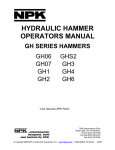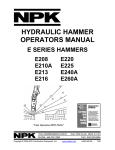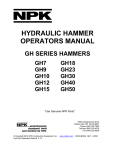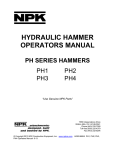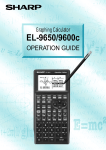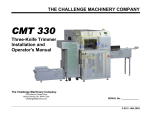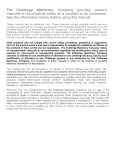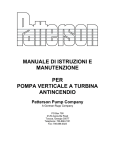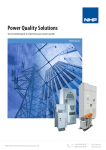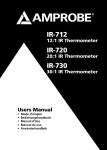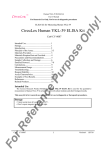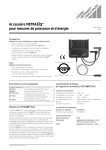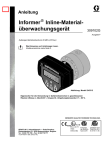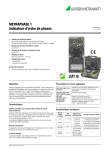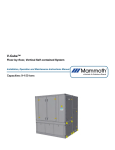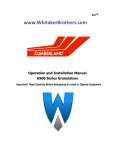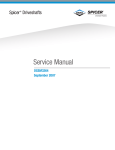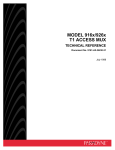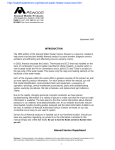Download hydraulic hammer operators manual
Transcript
HYDRAULIC HAMMER OPERATORS MANUAL GH SERIES HAMMERS GH9 GH10 GH12 GH15 GH18 GH30 "Use Genuine NPK Parts” 7550 Independence Drive Walton Hills, OH 44146-5541 Phone (440) 232-7900 Toll-free (800) 225-4379 Fax (440) 232-6294 © Copyright 2007 NPK Construction Equipment, Inc. www.npkce.com H050-9630B 08-07 08/07 NPK CONTENTS SAFETY .......................................................................................................................... 2 INTRODUCTION............................................................................................................. 4 CARRIER MACHINE COMPATIBILITY .......................................................................... 4 HAMMER SPECIFICATIONS ......................................................................................... 5 HYDRAULIC INSTALLATION ......................................................................................... 6 PREVENTION OF CONTAMINATION ........................................................................ 7 HYDRAULIC QUICK DISCONNECTS ........................................................................ 8 MOUNTING INSTALLATION ........................................................................................ 10 MOUNTING TO THE CARRIER................................................................................ 11 REMOVAL FROM THE CARRIER ............................................................................ 11 LUBRICATION .............................................................................................................. 12 GREASING PROCEDURE ....................................................................................... 12 CORRECT GREASE AND GREASE INTERVALS .................................................... 13 NPK HAMMER GREASE ..................................................................................... 15 AUTOLUBE SYSTEMS............................................................................................. 15 LUBRICANT TERMS AND DEFINITIONS................................................................. 16 START-UP OPERATION .............................................................................................. 18 HAMMERS THAT ARE NEW, REBUILT, OR HAVE BEEN INACTIVE ...................... 18 BEFORE STARTING THE HAMMER........................................................................ 19 DAILY START-UP PROCEDURE ............................................................................. 19 OPERATION ................................................................................................................. 20 SAFE OPERATING INSTRUCTIONS ....................................................................... 20 OPERATING TECHNIQUES & PRECAUTIONS ....................................................... 21 ROUTINE INSPECTION AND MAINTENANCE............................................................ 26 TWENTY HOUR INSPECTION..................................................................................... 27 GAS CHARGE .............................................................................................................. 28 NITROGEN GAS PRESSURE .................................................................................. 28 GAS CHARGING KIT ................................................................................................ 28 CHECKING THE GAS PRESSURE .......................................................................... 29 CHARGING THE HAMMER ...................................................................................... 30 DISCHARGING THE GAS PRESSURE .................................................................... 31 TOOLS .......................................................................................................................... 32 STANDARD TOOLS ................................................................................................. 32 CHANGING THE TOOL ............................................................................................ 33 TOOL INSPECTION ................................................................................................. 34 MAXIMUM TOOL TO TOOL BUSHING CLEARANCE .............................................. 35 RETAINING PIN............................................................................................................ 37 TIE RODS ..................................................................................................................... 38 TIE ROD TORQUE ................................................................................................... 38 HAMMER FASTENER TORQUE .................................................................................. 39 STORAGE OF HYDRAULIC HAMMER ........................................................................ 40 NOTES AND RECORDS .............................................................................................. 41 -1- NPK SAFETY Safety notices in NPK Instruction Manuals follow ISO and ANSI standards for safety warnings: DANGER (red) notices indicate an imminently hazardous situation which, if not avoided, will result in death or serious injury. WARNING (orange) notices indicate a potentially hazardous situation which, if not avoided, could result in death or serious injury. CAUTION (yellow) notices indicate a potentially hazardous situation, which, if not avoided, may result in minor or moderate injury. ATTENTION (blue) notices in NPK Instruction Manuals are an NPK standard to alert the reader to situations which, if not avoided, could result in equipment damage. WARNING and BASIC OPERATING INSTRUCTIONS decals are included with each NPK hammer and installation kit. Decals must be installed in the cab, visible to the operator while operating the hammer. STAY CLEAR, PRESSURE VESSEL, GAS PRESSURE and TOOL SHARPENING decals are installed on all NPK hammer models. Keep them clean and visible. NPK will provide decals free of charge as needed. 1. Operator and Service personnel must read and understand the NPK INSTRUCTION MANUALS to prevent serious or fatal injury. 2. FLYING DEBRIS CAN CAUSE SERIOUS OR FATAL INJURY. • Keep personnel and bystanders clear of hammer while in operation. • Do not operate HAMMER without an impact resistant guard between HAMMER and operator. NPK recommends LEXAN or equivalent material, or steel mesh. Some carrier manufacturers offer demolition guards for their machine. Check with the carrier manufacturer for availability. If not available, please call NPK. 3. Do not hardface or sharpen the tool point with a cutting torch. Excessive heat from torching or welding can cause embrittlement, breakage, and flying pieces. Resharpen by milling or grinding only, using sufficient coolant. Warning Decal for Cab Installation -2- NPK SAFETY, CONTINUED 4. Fully extend the tool while charging the HAMMER with nitrogen gas. Be sure that the retaining pin is installed. STAY CLEAR OF TOOL POINT WHILE CHARGING. 5. Do not disassemble a HAMMER before discharging the hammer gas pre-charge. 6. USE NITROGEN GAS ONLY! Store and handle nitrogen tanks per OSHA regulations. 7. Avoid high pressure fluids. Escaping fluid under pressure can penetrate the skin causing serious injury. Relieve pressure before disconnecting hydraulic or other lines. 8. Operate HAMMER from operator’s seat only. 9. Match HAMMER size to carrier according to NPK recommendations. The carrier must be stable during hammer operation and during transport. See CARRIER MACHINE COMPATIBILITY section of the NPK Service Manual. 10. Do not make any alterations to the TOOL without authorization from NPK Engineering. 11. Use proper lifting equipment and tools when handling or servicing the HAMMER. 12. Wear ear protection and safety glasses when operating the hammer. Consult OSHA/MSHA regulations when applicable. 13. Beware of flying metal pieces when driving Boom Pins. 14. Do not alter the HAMMER without authorization from NPK Engineering! 15. Use only genuine NPK replacement parts. NPK specifically disclaims any responsibility for any damage or injury that results from the use of any tool or parts not sold or approved by NPK. For further safety information, consult the AEM Hydraulic Mounted Breakers Safety Manual, AEM form MB-140 (NPK P/N H050-9600), which is furnished with every NPK hammer. To request an additional copy, please contact NPK at 800-225-4379 or Internet at www.npkce.com. -3- NPK INTRODUCTION NPK is a leading manufacturer of boom mounted HYDRAULIC HAMMERS, and has the most complete product line available anywhere. The success of NPK is due to our commitment to quality, dependability and long life. The HYDRAULIC HAMMER has many unique designed features and it is a company philosophy that the NPK HYDRAULIC HAMMER can be brought to "like new” condition long after competitive products are scrapped. You can feel confident that you have purchased the best value available. This comprehensive manual contains instructions for operating and maintaining NPK HYDRAULIC HAMMERS. This manual includes helpful information for obtaining the full potential and efficiency from NPK HYDRAULIC HAMMERS. Please read this manual thoroughly to understand the NPK HAMMER and its operating principles before using it. For additional information or help with any problem encountered, please contact your NPK authorized dealer. Whenever repair or replacement of component parts is required, only NPK parts should be used. NPK is not responsible for failures resulting from substitution of parts not sold or approved by NPK. CARRIER MACHINE COMPATIBILITY These carrier weight ranges are intended as a guideline only. Other factors, such as stick length, counterweights, undercarriage, etc., must be taken into consideration. Mounting a HAMMER that is too heavy for the carrier machine can be dangerous and can damage the carrier. Verify carrier stability with HAMMER before transport or operation. Mounting a HAMMER that is too small for the carrier machine can damage the HAMMER, cause tool breakage and void Warranties. Please consult NPK Engineering for specific detailed information. CARRIER WEIGHT lbs. (kg) HAMMER MODEL RECOMMENDED CARRIER WEIGHT RANGE (lb) (kg) GH9 40,000 - 56,000 18,000 - 25,000 GH10 46,000 - 66,000 20,000 - 30,000 GH12 56,000 - 86,000 25,000 - 38,000 GH15 66,000 - 100,000 30,000 - 45,000 GH18 70,000 - 114,000 32,000 - 52,000 GH30 100,000 - 186,000 45,000 - 85,000 Specifications subject to change without notice. -4- NPK HAMMER SPECIFICATIONS HAMMER IMPACT FREQUENCY MODEL ENERGY CLASS ft lb bpm WORKING WEIGHT lbs (Kg) TOOL WORKING LENGTH in (mm) in (mm) DIA GH9 3000 500 - 670 3600 (1635) 4.96 (126) 24 (608) GH10 4000 400 - 550 4200 (1900) 5.35 (136) 24.5 (620) GH12 5500 380 - 480 5650 (2565) 5.75 (146) 25.5 (650) GH15 8000 320 - 400 6800 (3085) 6.14 (156) 27 (690) GH18 12000 300 - 400 7800 (3540) 6.50 (165) 29 (740) GH30 15000 310 - 390 13500 (6125) 7.2 (184) 32 (815) HAMMER MODEL OIL FLOW gpm (L/min) HYDRAULIC OPERATING PRESSURE 1 CIRCUIT RELIEF minimum 2 psi (bar) GAS CHARGE PRESSURE 5 psi (bar) Cold 3 psi (bar) Hot 4 psi (bar) GH9 40 - 53 (150 - 200) 2600 (180) 3100 (215) 365 (25) 420 (29) GH10 44 - 55 (165 - 210) 2600 (180) 3100 (215) 365 (25) 420 (29) GH12 45 - 58 (170 - 220) 2650 (183) 3150 (217) 365 (25) 420 (29) GH15 53 - 66 (200 - 250) 2600 (180) 3100 (215) 365 (25) 420 (29) GH18 58 - 77 (220 - 290) 2500 (172) 3000 (207) 365 (25) 420 (29) GH30 74 - 92 (280 - 350) 2600 (180) 3100 (215) 390 (27) 450 (31) *Specifications subject to change without notice. NOTES: 1. Hydraulic operating pressure maximum is inlet pressure at the hammer with the oil at operating temperature and with the gas charge set at the hot operating pressure. See CHECKING THE HYDRAULIC PRESSURES section in Service Manual. 2. Circuit relief pressure is at least 500 psi (35 bar) above hammer operating pressure. 3. Cold gas charge is the initial set with the hammer at ambient temperature. 4. Hot gas charge is checked after 1 to 2 hours of running and with a system oil temperature of 140° to 180°F (60° to 80°C). This is the preferred check. 5. Pressures listed are maximum. Use tolerance of minus 25 psi (2 bar). -5- NPK HYDRAULIC INSTALLATION NPK INSTALLATION KITS are available for virtually all compatible backhoe loaders, excavators, and skid steers. Complete parts and instructions for the hydraulic installation of the NPK HYDRAULIC HAMMER including valving and/or controls, hoses and fittings, accumulators, boom and stick tubing, and clamps are provided. HAMMER LINES Typically, the pressure line is arranged on the left side of the boom and the return line on the right side. Flow to the hammer is controlled from an auxiliary valve on the carrier or from an NPK supplied valve. Hydraulic oil is routed back to the tank through the carrier’s oil cooler and filter. ACCUMULATORS General guideline requirements. Pressure Line Return Line Accumulator Accumulator GH9, GH10, GH12 1* 1 GH15, GH18, GH30 1* 2 * For gear pump machines only. * Some installations may have special requirements. MODEL HAMMER CONTROL VALVE NPK uses two general types of control systems, depending upon the carrier model: 1. CONTROL SYSTEM USING CARRIER AUXILIARY OR SPARE VALVE SECTION. This type of installation utilizes an existing carrier valve. Any additional parts, such as a mechanical linkage, hydraulic pilot control valve, flow control valves, etc., are furnished in the NPK HYDRAULIC INSTALLATION KIT. Special hydraulic pressure control valves are not required. The NPK HYDRAULIC HAMMER operating pressure is self-regulating. 2. CONTROL SYSTEM USING THE NPK MULTIVALVE. For carriers not equipped with a suitable auxiliary or spare valve section, the NPK HYDRAULIC INSTALLATION KIT includes a solenoid operated, priority flow control valve to operate the NPK HYDRAULIC HAMMER. The NPK MULTIVALVE is specifically designed for the operation of boom mounted attachments. -6- NPK HYDRAULIC INSTALLATION, CONTINUED ATTENTION PREVENTION OF CONTAMINATION 1. A hydraulic hammer is harder on oil than using a bucket, so the oil is apt to deteriorate and breakdown sooner. Neglect of the hydraulic oil can not only damage the hydraulic hammer but also cause problems in the carrier, which could result in damaged components. Care should be taken to check for contamination of the oil and to change it if it is found contaminated. Oil sampling at regular intervals is highly recommended. When the hydraulic oil shows low viscosity and bubbles, this indicates that the oil is deteriorated. If the oil is dark brown and gives off an offensive odor, it is severely deteriorated. Change the oil immediately! When the oil is clouded, or the oil filter has become clogged, it indicates that the oil is contaminated. Change the oil immediately! To change the contaminated hydraulic oil, drain the hydraulic system completely and clean components. Do not mix new oil with the old. 2. Do not allow any contamination to mix with the oil. Take special care in preventing contamination from entering the hydraulic system through the hose or tube connection when changing the hydraulic hammer with the bucket. 3. Low oil level will cause heat build-up, resulting in deterioration of the oil. Also, it may cause cavitation due to air mixing with the oil, leading to a damaged hydraulic hammer and carrier components. Keep the oil at the proper level at all times. 4. Do not use the hydraulic hammer at an operating temperature higher than 180°F (80°C). The proper operating oil temperature range is between 120°F (50°C) and 180°F (80°C). Since clogged cooler fins causes reduced efficiency of the cooler, keep the cooler fins clean at all times. Check the hydraulic oil cooling system to be sure it is working effectively. The use of a heat gun is the best way to evaluate if the cooler is working properly. 5. Water in the hydraulic oil will lead to damage of the hydraulic hammer and carrier. Drain off water and foreign matter from the hydraulic tank at specified intervals. When out of service, the hydraulic hammer should be stored indoors. CHANGING THE FILTER ELEMENT AND HYDRAULIC OIL Change the filter element and hydraulic oil at the intervals described in the operation manual of the excavator when using a hydraulic implement. Another method is to set up an oil sampling schedule and change accordingly. -7- NPK HYDRAULIC INSTALLATION, CONTINUED HYDRAULIC QUICK DISCONNECTS NPK recommends against the use of non-NPK quick disconnects on hydraulic circuits operating NPK Products. 1. The hydraulic pulsations caused by hydraulic hammer operating can cause internal pieces of non-NPK quick disconnects to disintegrate. These pieces would migrate into the hammer, causing damage. 2. If quick disconnects are used when the hammer is removed from the excavator, the quick disconnects should be capped to keep them clean. If this is not done, contamination on the disconnect will be flushed into the hammer when re-connected. This, again, can cause damage. 3. Most quick disconnects create a restriction in the circuit. NPK Hammers are not back pressure sensitive, but restrictions cause unnecessary heating of the oil. Also, the pressure required to operate the hammer, plus the restriction of the disconnects may push an older, low pressure, carrier machine to the limit of its hydraulic system. This would interfere with proper hammer operation. However, the NPK approved quick disconnects are properly sized so that the hammer operation is not affected. NOT RECOMMENDED CONNECTION APPROVED CONNECTION (A) Non-NPK Quick Disconnects (B) NPK APPROVED CONNECTION QUICK DISCONNECTS CONTACT YOUR NPK DEALER FOR ADDITIONAL INFORMATION ABOUT NPK QUICK DISCONNECTS -8- NPK HYDRAULIC INSTALLATION, CONTINUED HYDRAULIC QUICK DISCONNECTS If hydraulic quick disconnects are used with the NPK Hammer, it is recommended that the following precautions be followed. 1. Periodic inspection of both male and female ends (A) is recommended to ensure the couplers are in good working condition. Failure to inspect couplers may result in pieces from a damaged or failed coupler to migrate into the hammer or parts of the coupler returned to the machine. 2. Check for dirt, dust, and debris on both couplers before coupling. 3. Be sure that the couplers are completely seated together (B). 4. For most non-NPK couplers, be sure that couplers are replaced as a set, male and female. Do not use one new end and one used end. -9- NPK MOUNTING INSTALLATION NPK Mounting Installation Kits include the parts required to adapt the NPK HYDRAULIC HAMMER to the carrier. NPK mounting kits include the hammer mounting bracket (A), flow control valve (if required), and hoses to connect to the carrier hydraulic system. ITEM A B C D E F G DESCRIPTION TOP BRACKET WHIP HOSES HAMMER HOSES FITTINGS BOLTS PINS (IF REQUIRED) (NOT SHOWN) BUSHINGS (IF REQUIRED) (NOT SHOWN) Refer to HAMMER FASTENER TORQUE section for Top Bracket bolt torque. Refer to NPK Installation Kit Manual for additional information. - 10 - NPK MOUNTING INSTALLATION, CONTINUED MOUNTING TO THE CARRIER 1. Place the hammer horizontal on wood blocks, as shown. 2. Align the boom pin holes. Install the stick pin (C) before the cylinder link pin (D). 3. Clean away any dirt found on the hose connections and connect hoses (E). Pressure line is on left, return line on right side of boom. 4. Open shut-off valves (F). REMOVAL FROM THE CARRIER ATTENTION The hydraulic lines must be handled carefully and sealed to prevent contamination from entering the hammer or the carrier hydraulic system. ATTENTION The tool end of the hammer should be set lower than the head end to prevent moisture from entering the hammer through the tool area. 1. Close pressure and return line shutoff valves (A). 2. Disconnect the hydraulic hoses (B) before laying the hammer down. Avoid getting hydraulic oil on rubber mounts (C). Flush with water if necessary. 3. Cap the pressure and return lines on the carrier (D) and connect the hammer whip hoses as shown. 4. Position the hammer horizontal on wood blocks and remove the boom pins. - 11 - NPK LUBRICATION GREASING PROCEDURE Manual greasing for hammers without AUTOLUBE system IMPORTANT: 1. The hammer must be in a vertical position with downforce applied to push the tool all the way in. This prevents grease from entering piston impact area. 2. Turn the machine off. 3. Grease the hammer until grease begins to come out around the tool and lower bushing. APPLY DOWNFORCE TO PUSH TOOL UP INTO HAMMER NOTE: USE A GOOD QUALITY EP #2 LITHIUM BASED GREASE WITH WEAR INHIBITING ADDITIVES, SEE PAGES 13, 14, AND 15. - 12 - NPK LUBRICATION, CONTINUED CORRECT GREASE AND GREASE INTERVALS Proper hammer maintenance requires a sufficient supply of the correct grease to the tool (chisel). The tool must be pressed against a hard surface until it stops up inside the hammer. This prevents grease from entering piston impact area and ensures proper distribution of grease between the tool and tool bushings. GREASE INTERVALS If the hammer is not connected to an Autolube system, see page 15, the hammer must be greased at regular intervals to get the best life from the tool and tool bushings. There are two ways to determine grease intervals: First, grease the hammer at the beginning of the job until grease comes out between the tool and the lower tool bushing. Run the hammer until the shank of the tool starts to look dry. This determines the time interval for the greasing of this particular hammer on this particular job. Typically, this is 1 to 4 hours. Also, note the amount of grease needed to re-grease the tool. This gives you the amount of grease and how often it must be applied. An example would be that a particular hammer, on a particular job, requires half a tube of grease every 3 hours. This would be the greasing schedule you would set up. If this hammer was moved to another job, another grease schedule may have to be determined. Second, if you can’t control the grease schedule, such as rental units, then have the operator grease the hammer once every hour of hammer operation. Again, grease the hammer until grease comes out between the tool and tool bushing. This is usually more often than required, but is far cheaper than replacing prematurely worn tools and tool bushings. CORRECT GREASE The type of grease used is very important. NPK recommends a lithium soap base EP (Extreme Pressure) NLGI #2 Grease, with Moly (Molybdenum Disulfide) or other surface protecting additives. A high drop point 500° F (260° C) grease is desirable. On the following page is a list of commonly available greases, by manufacturer and brand name that meet NPK’s recommendations. NPK does not endorse any one brand as being superior to another. If you or your customers use a brand not listed, please call the NPK Service Department at 800-225-4379. - 13 - NPK LUBRICATION, CONTINUED CORRECT GREASE FOR HYDRAULIC HAMMERS, continued MANUFACTURER Amalie Oil Co. Amoco BRAND NAME Amsoil, Inc. BP Oil, Inc. Caterpillar Cato Oil and Grease Company CITGO Conoco, Inc. Dryden Oil Company Exxon Fiske Brothers Refining Co. (Lubriplate) John Deere Kendall Mobil Muscle Products Corporation (MPC) GHD NPK Universal Plus Lithium EP Grease Super Duty EP Grease (water resistant) Chisel Paste Pennzoil Phillips 66 Company Shell Adhezolith EP 2 Grease Philube MW Standard Oil Company Sun Refining & Marketing Company Texaco, U.S.A. Union Oil Company Unocal LI-2M Rykotac EP Grease Amolith Grease 94601 Rykon Premium Grease EP (Grade 94108) Rykon Premium Moly Grease (Grade 94114) Amoco Molylith Grease 92006 Bearing Gard-2 Multipurpose Molydbenum Grease (MPGM) Moly Lithflex CX AS Citgo Extra Range Grease Super Lube M EP #2 Moly EP 2 Ronex Extra Duty Moly NLGI 2 MO-LITH No. 2 TY6333/TY6341 Moly High Temp L-424 Moly 372 PL-10 Powerlift Grease LP-10 Lithium EP Plus Retinax ® AM Grease 71119 Retinax ® HD Grease Bearing Gard-2 Prestige Moly 2 EP Molytex EP 2 Unoba Moly HD #2 Unoba Moly HD #2 - 14 - NPK LUBRICATION, CONTINUED CORRECT GREASE FOR HYDRAULIC HAMMERS, continued NPK HAMMER GREASE NPK now offers hammer grease specially formulated to meet severe job requirements. The grease is available in three different temperature ranges - 350°, 500°, and 2000°. All are compatible with Autolube systems. Universal Plus and Super Duty are lithium soap based products that resists washout and contain NPK-10 additive for surface protection in friction effected areas. Chisel Paste is an aluminum complex soap base with 12% graphite and copper additives for extreme operating conditions. UNIVERSAL PLUS NPK PART 350 deg NO. 14 OZ. CARTRIDGE G000-1010 120 LB. KEG G000-1020 35 LB. PAIL G000-1030 400 LB. DRUM G000-1040 SUPER DUTY NPK PART 500 deg NO. 14 OZ. CARTRIDGE G000-1011 120 LB. KEG G000-1021 35 LB. PAIL G000-1031 400 LB. DRUM G000-1041 CHISEL PASTE NPK PART 2000 deg NO. 14 OZ. CARTRIDGE G000-1050 AUTOLUBE SYSTEMS An automatic greasing system is recommended to reduce hammer tool and tool bushing wear. The NPK AUTOLUBE System is designed to automatically provide a continuous supply of grease to the hammer tool and tool bushing – increasing tool and tool bushing life by reducing wear. The AUTOLUBE pump is capable of pumping EP2 grease in cold weather. The pump output is adjustable according to the requirements of the hammer model and to compensate for tool bushing wear. NPK GH series hammer models have a connection port (A) for an automatic greasing system. Refer to the NPK AUTOLUBE Instruction Manual for details. - 15 - NPK LUBRICATION, CONTINUED LUBRICANT TERMS AND DEFINITIONS TERM ADHESIVE ANTI WEAR AGENTS COHESIVE CONSISTENCY CONTAMINATION DROPPING POINT EXTREME PRESSURE AGENTS FILM STRENGTH FRICTION GALLING LUBRICATION NLGI OILINESS PUMP DEFINITION The ability of grease, gear lubricant or oil to cling to metal. Used to help combat metal-to-metal contact, thus reducing wear. The ability of grease, gear lube or oil to cling to itself, thus resisting tearing apart. Consistency of grease is its hardness or firmness. It is determined by the depth in millimeters to which the cone of a penotrometer sinks into a sample under specified conditions. Consistency of grease may be influenced by the type and amount of thickener, viscosity of oil, working and other factors. Foreign material that could damage a part. The minimum temperature at which the oil in a grease subjected to heat begins to actually drip and breakdown. Additives that under extreme pressure form an adherent film on metal surfaces, thus forming a film of protection. Film strength is defined as the tendency of oil molecules to cling together. It is the ability of those molecules to resist separation under pressure between two metals and to hold these metal surfaces apart. The resistance to fluid flow in a hydraulic system. (An energy loss in terms of power output.) Surface damage on mating, moving metal parts due to friction. A severe form of adhesive wear. Use of a substance (grease, oil, etc.) to reduce friction between parts or objects that move against each other. A rating given to a grease from the National Lubricating Grease Institute. This rating determines the hardness of the grease and goes on from a 000 to a 6 rating. Most greases are NLGI #2 rated. Oiliness is measured of the coefficient of friction of a lubricant. Oiliness or lubricity depends on the adhering characteristics of an oil. It is determined by the attraction between the molecules of the oil and the molecules of another material. Of two oils having the same viscosity but different degrees of fluid friction, the one with the lower friction index has the higher degree of oiliness. A device which converts mechanical force into hydraulic fluid power. Basic design types are gear, vane, and piston units. - 16 - NPK LUBRICATION, CONTINUED LUBRICANT TERMS AND DEFINITIONS, continued TERM RESERVOIR VIBRATION VISCOSITY DEFINITION A container for keeping a supply of working fluid in a hydraulic system. A quivering or trembling motion. Is the actual SAE weight of the product. Example motor oils come in 10, 20, 30, 40, 50 and 15/40 SAE weight. The viscosity designation of a lubricant indicates its internal resistance to flow. - 17 - NPK START-UP OPERATION HAMMERS THAT ARE NEW, REBUILT, OR ATTENTION HAVE BEEN INACTIVE Before using a new hammer for the first time, the first time after rebuild, or a hammer that has been inactive for a long period of time: 1. Check the nitrogen gas pressure. The nitrogen gas pre-charge is factory checked before shipment. However, it is recommended the pressure be checked before using the NPK hydraulic hammer for the first time. See CHECKING THE GAS PRESSURE section for procedure. 2. At idle, raise the hammer off of the ground. Place hammer vertical and activate the hammer circuit for 3 – 5 second intervals. Continue for an additional 3 – 4 times to ensure that all the air has been purged from the hoses and hammer before first use. Failure to do this could result in damage to internal components. 3. Place hammer firmly against material to be broken. Operate the hammer in a vertical position for approximately 10 minutes at one-half engine speed. Increase engine speed to three-quarters and continue operating at this speed for another 10 to 20 minutes. Increase to full engine speed. Maintain vertical position for the first hour of operation. - 18 - NPK START-UP OPERATION, CONTINUED ATTENTION BEFORE STARTING THE HAMMER PRE-OPERATION INSPECTION AND WARM UP Before operating the NPK hydraulic hammer, be sure to perform the specified routine inspection in the ROUTINE INSPECTION AND MAINTENANCE section of this manual. Warm up the NPK hydraulic hammer, see below, and the carrier machine in accordance with the machine manufacturer’s instruction manual. This is especially important during cold weather operation. DAILY START-UP PROCEDURE Operate the NPK hydraulic hammer in the vertical position, at 1/2 engine throttle setting, for about 1-2 minutes. During this period, inspect the NPK hydraulic hammer and installation kit for leaks or loose connections. Do not operate on a slanted surface during the start-up operation. - 19 - NPK OPERATION SAFE OPERATING INSTRUCTIONS DO NOT OPERATE THE HAMMER WITHOUT AN IMPACT RESISTANT CAB WINDOW OR SHIELD IN PLACE BEWARE OF FLYING DEBRIS FROM THE HAMMER TOOL POINT An impact resistant cab window or shield must be in place to protect the operator. DO NOT USE THE HAMMER AS A HOIST The hammer is not intended to lift an object. To do so, can be dangerous. DO NOT TOUCH HOT TOOL AFTER USING! - 20 - NPK OPERATION, CONTINUED ATTENTION OPERATING TECHNIQUES & PRECAUTIONS PRELOAD THE TOOL BEFORE STARTING Press the tip of the demolition tool vertically against the object to be broken. Be sure the object is stable before activating the NPK HYDRAULIC HAMMER. APPLY DOWNFORCE ON THE TOOL Raise the front of the machine slightly (A) by applying downforce on the demolition tool. Press the control lever or the foot pedal to start the NPK HYDRAULIC HAMMER. Applying excessive force to the hammer will raise the carrier too high and jolt the operator when the material breaks. Let the NPK HYDRAULIC HAMMER do the work. AVOID BLANK HAMMERING As soon as the material is broken, release the control lever or pedal to prevent unnecessary blank hammering. Blank hammering is continued hammer operation after the material is broken. This will overheat the hydraulic system and cause undue wear. - 21 - NPK OPERATION, CONTINUED ATTENTION OPERATING TECHNIQUES & PRECAUTIONS DO NOT SLANT HAMMER For the most efficient demolition, align the direction of force (F) from the boom with the penetration direction (P) of the tool. Failure to do this decreases the transfer of energy from the piston to the rock and increases the bending forces at the fulcrum of the tool. This unnecessary added stress leads to the following problems: 1. Premature bushing wear and/or tool breakage. 2. Breakage of tie rods. 3. Breakage of bracket bolts. 4. Decrease in transfer of energy translates to reduced production. When the tool binds from incorrect working angle, the sound of the hammer changes. Keep the boom direction of force in the same direction the tool is penetrating (A). Use the boom cylinder to preload the hammer (apply downforce), and use the bucket and stick cylinders for alignment. Keep the tool tangent to the arc of the boom (B). - 22 - NPK OPERATION, CONTINUED ATTENTION OPERATING TECHNIQUES & PRECAUTIONS DO NOT USE THE HAMMER TOOL AS A PRY BAR Excessive prying can cause premature bushing wear and tool or tie rod breakage. When hammering materials that allow the tool to penetrate before breaking, move the hammer slightly fore and aft to create a cone-shaped hole. The vented hole allows trapped dust and heat to escape, increases the tool penetration rate into the material, and prevents overheating the tool tip. DO NOT HAMMER CONTINUOUSLY IN THE SAME POSITION FOR MORE THAN 30 SECONDS If the tool cannot break or penetrate into the material after hammering in the same position for 30 seconds, change the working location. Hammering in the same position for a long time will reduce the working efficiency, increase the hydraulic oil temperature, overheat the tool tip and accelerate tool wear. ALWAYS WORK BY BREAKING TO A FREE FACE The material must have somewhere to break to. Start at an edge. - 23 - NPK OPERATION, CONTINUED ATTENTION OPERATING TECHNIQUES & PRECAUTIONS DO NOT DROP THE HAMMER RAPIDLY ON AN OBJECT Remember, the hydraulic hammer is heavier than an empty bucket and will move faster than expected. DO NOT USE THE HAMMER OR BRACKET TO MOVE LARGE OBJECTS Do not use the hammer bracket for purposes other than for what is was intended. AVOID OPERATING THE HAMMER WITH CYLINDERS AT THE END OF STROKE Continuous operation with the boom cylinders fully retracted or extended may damage the hydraulic cylinders. - 24 - NPK OPERATION, CONTINUED ATTENTION OPERATING TECHNIQUES & PRECAUTIONS DO NOT OPERATE HAMMER UNDERWATER UNLESS HAMMER HAS BEEN MODIFIED WITH UNDERWATER KIT Do not allow parts, other than the tool, to be submerged in water. Underwater operation will damage the hammer and allow water to enter the hydraulic system. The hammer can be modified for underwater operation - contact NPK at 800-225-4379 for more information. DO NOT SUBMERGE A HOT TOOL IN WATER! The tip of the tool may be hot from operation. Submerging in water can cause the tip of the tool to become brittle and break prematurely. DO NOT ALLOW THE HAMMER TOOL TO HIT THE BOOM Use caution when tucking the hammer in tight to the boom for transportation. - 25 - NPK ROUTINE INSPECTION AND MAINTENANCE 1. VISUAL INSPECTION Detect a potential problem early. FASTENERS Inspect all fasteners. Retighten as necessary. Refer to HAMMER FASTENER TORQUE section, page 39, for Top Bracket bolt torque. WELDS Check for cracks, repair as necessary. HOSES AND TUBING Check for oil leaks, loose clamps and hose abrasion. HYDRAULIC OIL MAINTAIN A CLEAN HYDRAULIC SYSTEM If non-petroleum oil is used, contact NPK Service Department for compatibility. Keep hoses clean and capped when dismounting or storing hammer. Change oil and filters as recommended by carrier manufacturer. Periodic oil sampling is recommended. 2. DEMOLITION TOOL LUBRICATION Important: It is imperative that grease is maintained in the tool bushing contact area at all times. This may require hourly greasing depending on job conditions. Important: The hammer must be in a vertical position with downforce applied to push the tool all the way in. This prevents grease from entering piston impact area. Pump grease into hammer until grease is seen coming out between the tool and bushing. Use a good quality, high temperature EP#2 grease containing anti-wear additives, see LUBRICATION section. If machine is equipped with an AUTOLUBE System, check grease reservoir daily. 3. TOOL and TOOL BUSHING WEAR Check the tool and tool bushings for damage, wear or deformation on a regular weekly basis. Replace the tool and/or bushings when wear exceeds the maximum clearance limit, see MAXIMUM TOOL TO TOOL BUSHING CLEARANCE section, page 35. Do not hardface or sharpen the tool point with a cutting torch. Excessive heat from torching or welding causes embrittlement, breakage, and flying pieces. Resharpen only with a surface grinder or milling machine using sufficient cooling. Please consult your authorized NPK Dealer or NPK Service Department for additional information. - 26 - NPK TWENTY HOUR INSPECTION 1. WARRANTY REGISTRATION Complete and send to NPK after initial 20 hour inspection. 2. WELDS Check for cracks, repair as necessary. Consult your authorized NPK Dealer or NPK Service Department for additional information. 3. TOOL RETAINING PIN Remove the retaining pin and inspect for peening caused by excessive blank hammering. If necessary, grind edges smooth as shown in TOOL RETAINING PIN INSPECTION section. The retaining pin must rotate freely. 4. DEMOLITION TOOL Remove the demolition tool and inspect for peening caused by excessive blank hammering. If necessary, grind edges smooth as shown in TOOL INSPECTION, section. 5. GAS CHARGE Check and adjust, if required, see GAS CHARGE section. - 27 - NPK GAS CHARGE NITROGEN GAS PRESSURE The nitrogen gas pressure must be measured with no preload on the tool. Remove the tool; or position the hammer with the tool fully extended against the tool retaining pin. The hammer must not be resting vertical on the tool. The gas pressure in the hammer will vary according to the gas temperature. PREFERRED METHOD The preferred method to measure or charge the nitrogen gas pressure is with the hydraulic system temperature stabilized at maximum operating temperature. The chart showing values for “Operating Temperature” should be used, see below. ALTERNATE METHOD The nitrogen gas pressure can be measured or charged at ambient temperature (cold), before operating the hammer. See the chart “Ambient Temperature” below. ATTENTION DO NOT OVERCHARGE THE HAMMER! Exceeding the gas pre-charge specifications can result in damaging hammer components. The NPK WARRANTY does not cover failures resulting from exceeding the specified nitrogen gas pressure. NITROGEN GAS PRE-CHARGE SPECIFICATIONS MODEL AT AMBIENT TEMPERATURE (cold, before operating) PSI (BAR) (plus 0, minus 25) AT OPERATING TEMPERATURE 365 (25) 420 (29) 390 (27) 450 (31) PSI (BAR) (plus 0, minus 25) GH9 GH10 GH12 GH15 GH18 GH30 GAS CHARGING KIT ALL NPK HYDRAULIC HAMMERS are furnished with the following gas charging kit. In addition, a nitrogen tank and pressure regulator valve (not furnished with the hammer) are required. These can be obtained from your local welding supply house. A regulator valve is available from NPK. GAS CHARGE KIT (PART NO. 7300588) 1. HOSE (PART NO. 20118010) 2. PLUG (PART NO. 30102050) 3. CHARGE ADAPTER (PART NO. 30604040) 4. CHARGING KIT BOX (PART NO. 35001030) 5. CAP (PART NO. 30100500) 6. OPTIONAL REGULATOR VALVE (PART NO. 21101050) - 28 - NPK GAS CHARGE, CONTINUED CHECKING THE GAS PRESSURE Inspect the nitrogen gas pressure every 100 hours. PROCEDURE 1. The gas pre-charge is measured with no preload on the tool. Remove the tool or position the hammer with the tool fully extended. THE HAMMER MUST NOT BE RESTING ON THE POINT. 2. Remove the charge valve cap (A). 3. Turn the NPK charge adapter T-handle (A) full counterclockwise. 4. Install the NPK charge adapter (A) on the hammer charge valve (B). Remove the valve cap only, not the charge valve assembly! 6. Turn the T-handle (A) clockwise. As the Thandle (A) is screwed in, a resistance is encountered. By turning the T-handle (A) further, the nitrogen gas pressure will be indicated on the pressure gauge (B). Stop turning the T-handle (A) when the gauge (B) reads pressure. Do not overtighten. 5. Tighten the charge adapter cap (A). 7. Compare the gauge pressure with the NITROGEN GAS PRE-CHARGE chart in the NITROGEN GAS PRESSURE section. If the gas pressure is 25 psi (2 bar) or more below specification, proceed to NITROGEN GAS CHARGING PROCEDURE. If the pressure is correct, go to the next step. 8. Turn the T-handle counterclockwise until it stops as in step 3. 9. Slowly loosen the charge adapter cap to relieve the nitrogen gas pressure trapped in the charge valve. 10. Remove the charge adapter from the hammer charge valve. 11. Replace the charge valve cap on the charge valve. - 29 - NPK GAS CHARGE, CONTINUED CHARGING THE HAMMER USE NITROGEN GAS ONLY STAY CLEAR OF THE TOOL WHILE CHARGING THE HAMMER WITH GAS. The tool may be impacted by the piston and forced out abruptly. PROCEDURE 1. Carry out steps 1 thru 4 of CHECKING THE GAS PRESSURE. 2. Remove the cap from the charge adapter. Remove the valve cap only, not the charge valve assembly! 3. Install a pressure 4. Connect a hose (D) from 6. Turn the handle on the tank regulator (A) on a the pressure regulator (A) regulator (A) tank of nitrogen gas on the nitrogen tank (B) to counterclockwise to full (B). the charge adapter (C). closed. 5. Turn the T-handle (E) on 7. Open the valve (B) on the the charge adapter (C) nitrogen tank (C) by turning clockwise. the handle counterclockwise. 8. Slowly adjust the regulator on the nitrogen tank to the correct pressure by turning clockwise. Refer to NITROGEN GAS PRE-CHARGE chart in the NITROGEN GAS PRESSURE section. 9. Charge nitrogen gas (see gas charge decal (E) until the pressure gauge (A) on the charge adapter (B) is at the correct setting, then turn the T-handle (C) counterclockwise all the way out. 10. Close the nitrogen tank valve and then remove the hose (D) from the charge adapter. Nitrogen gas may be trapped in the hose. Loosen fittings slowly to release pressure. 11. Remove the charge adapter from the hammer charge valve. 12. Replace the charge valve cap. - 30 - NPK GAS CHARGE, CONTINUED DISCHARGING THE GAS PRESSURE PROCEDURE 1. Remove the charge valve cap (A). 2. Turn the NPK charge 3. Install the NPK charge adapter T-handle (A) adapter (A) on the full counterclockwise. hammer charge valve (B). Remove the valve cap only, not the charge valve assembly! 4. Tighten the charge adapter cap (A). 5. Turn the T-handle (A) clockwise. As the Thandle (A) is screwed in, a resistance is encountered. By turning the T-handle (A) further, the nitrogen gas pressure will be indicated on the pressure gauge (B). Stop turning the Thandle (A) when the gauge (B) reads pressure. Do not over tighten. - 31 - 6. Loosen the charge adapter cap (A) VERY SLOWLY. The gas pressure will gradually decrease to zero; then REMOVE THE CAP (A). 7. Remove the charge adapter (B) from the hammer and reinstall charge valve cap. NPK TOOLS STANDARD TOOLS TOOL TYPE SHAPE APPLICATIONS • Controlled breakage of concrete • Layered sedimentary rock -trenching, oversize • General demolition • Cutting casting gates • Concrete structures – columns, etc. • Soft material CHISEL Crosscut (FX) MOIL (P) • Concrete slab, bridge decking • Oversize • Slag removal BLUNT (E) • Hard rock • General demolition CORE (PC) *The crosscut (FX) tool cuts at right angle, or crosswise, to the stick and boom of the excavator. *FOR ADDITIONAL TOOL RELATED INFORMATION, PLEASE CONSULT THE NPK TOOL MANUAL, H040-9600C. - 32 - NPK TOOLS, CONTINUED CHANGING THE TOOL REMOVAL 1. Remove the retaining ring by using pliers or screwdrivers, see Figures 1 and 2. It will easily come out if pulled at an angle as shown in Figure 2. 2. Screw an M12 bolt or cap screw into the retainer pin. 3. Pull out retainer pin. If the retainer pin is jammed, use a hammer and drift from the opposite side. NOTE: THIS PROCEDURE DOES NOT APPLY TO THE MODEL GH30. Figure 1 Figure 2 RE-INSTALLATION 1. 2. 3. 4. 5. Clean the retainer pin housing hole and retaining ring groove. Coat the surface of the tool with grease, then install. Apply grease to the retaining ring housing groove. Coat the retaining pin with grease, then install. Install the retaining ring in the following manner: a. While deforming the retaining ring as shown in Figure 3, partially force it into the groove. b. Using the handle of the pliers or screwdriver, press the rest of the ring into the groove, see Figure 4. Figure 4 Figure 3 - 33 - NPK TOOLS, CONTINUED TOOL INSPECTION 1. Deformation may occur on the tool in the retaining pin contact area or on thrust surface (A). If these areas are mushroomed, the tool may become difficult to remove from the tool holder. Dress with a grinder. 2. Excessive blank hammering may cause chipping (A) in the retaining pin contact area. If neglected, the chipping may reduce the life of the retaining pin. Dress with a grinder (B). 3. If chipping (A) is found at the top of the tool, replace the tool. If neglected, the piston impact surface will be damaged. (C) is normal (D) is chipped - 34 - NPK TOOLS, CONTINUED MAXIMUM TOOL TO TOOL BUSHING CLEARANCE Replace the tool bushing (A), and/or tool (B), when the tool to bushing gap reaches the maximum clearance. To determine whether the bushing or tool requires replacement, follow the instructions and charts shown below: Step 1 Measure the tool to bushing gap (C) with the hammer horizontal, as illustrated below. If the clearance is at or greater than the charted maximum clearance, consult the NPK Hydraulic Hammer Service Manual to determine which component requires replacement. MODEL GH9 GH10 GH12 GH15 GH18 GH30 MAXIMUM CLEARANCE inch (mm) 3/8 (10) 3/8 (10) 1/2 (13) 1/2 (13) 1/2 (13) 5/8 (16) Step 2 Remove the tool from the tool holder. Measure the diameter (D) of the bearing surface of the tool, which is located on each side of the retaining pin groove. The minimum tool diameter is compared to a new tool bushing only. If the tool is at, or below the charted value, the tool must be replaced. MODEL GH9 GH10 GH12 GH15 GH18 GH30 NEW TOOL DIAMETER (D) inch (mm) 5.0 (126) 5.4 (136) 5.7 (146) 6.1 (156) 6.5 (165) 7.2 (183) - 35 - MINIMUM TOOL DIAMETER inch (mm) 4.6 (116) 5.0 (126) 5.2 (132) 5.6 (142) 6.0 (152) 6.6 (167) NPK TOOLS, CONTINUED MAXIMUM TOOL TO TOOL BUSHING CLEARANCE, CONTINUED Step 3 Measure the inside diameter of the lower and upper tool bushings. The maximum tool bushing inside diameter is compared to a new tool only. If the tool bushing dimensions are at or above the charted value, the bushing must be replaced. MODEL GH9 GH10 GH12 GH15 GH18 GH30 NEW BUSHING INSIDE DIAMETER inch (mm) 5.0 (126) 5.4 (136) 5.7 (146) 6.1 (156) 6.5 (165) 7.2 (184) MAXIMUM BUSHING INSIDE DIAMETER inch (mm) 5.4 (136) 5.8 (146) 6.2 (159) 6.6 (169) 7.0 (178) 7.8 (200) Step 4 Compare the tool and bushings to the charts in Step 2 and Step 3. Choose the new component (tool or bushing) that will bring the maximum clearance to below the value seen in the chart of Step 1. Obviously, replacing both the tool and bushings would bring the clearance back to new. - 36 - NPK RETAINING PIN The tool retaining pin serves to keep the tool in the hammer when the hammer is raised off the ground for repositioning. Additionally, the retaining pin will become worn during normal use. Figure (A) shows the retaining pin when it is new. Note: the two guide grooves. These areas and the area between the grooves are the areas where the wear will take place. If large, flat areas are found here, the pin must be replaced. This would indicate that the hammer is not being greased frequently enough. Normal wear will occur on the pin as shown in Figure (B). Grind this area on a bench grinder or with a disc grinder to remove any burrs. Reuse the pin. Figure (A) Figure (B) Note: The retaining pin is a wear item and will require replacement every so often. - 37 - NPK TIE RODS TIE ROD TORQUE See TIE ROD REPLACEMENT section of the Service Manual for complete procedure when replacing a Tie Rod. 1. Tighten all TOP NUTS with a TORQUE WRENCH to the recommended pre-torque specification shown in CHART 1. (It may take several passes at each top nut to achieve this.) Check that no gap is noted between the sections. 2. Mark all the TOP NUTS and HEAD as shown in figure 1. 3. Further tighten all the TOP NUTS to step #1 as shown in figure 1. 4. Further tighten all the TOP NUTS to step #2 as shown in figure 1. 5. Further tighten all the TOP NUTS to step #3 as shown in figure 1 using Chart 1 below for the appropriate number of flats per hammer model. Figure 1. Mark all Top Nuts. MODEL PreTorque Step #1. First turn (3 flats) Step #2. Second turn (3 more flats) Step #3. Final turn (see Chart 1) CHART 1. Total No. of Total No. of Flats Flats Using *Sweeney Using standard Anti-seize anti-seize 7 7.5 Socket Size inch (mm) 2-3/4” (70) GH9 Ft/lbs (Nm) 200 (270) GH10 200 (270) 7 7.5 2-3/4” (70) GH12 200 (270) 8 8.5 3-1/8” (77) GH15 400 (540) 8.5 9 3-1/8” (77) GH18 400 (540) 9.5 10 3-3/8” (85) GH30 1500 (2000) 2.5 3 3-5/8” (90) *Sweeney 503 Anti-seize recommended. *Note: Torque method for “GH” Hammers is different from method previously used on “H” and “E” Hammers. If you have any questions call NPK Service Department at 800-225-4379. - 38 - NPK HAMMER FASTENER TORQUE If hammer or hammer bracket fasteners are found to be loose, use the following charts. Medium strength thread adhesive should be used on all the valve assembly bolts and the gas charge valve. All other bolts should be lubed with anti-seize compound. SOCKET HEAD CAP SCREWS (SHCS) VALVE CASE MODEL VALVE TOP AND BOTTOM CAP SHCS TORQUE DIA ft/lb (Nm) M22 710 (960) GH9 SHCS DIA M24 TORQUE ft/lb (Nm) 900 (1220) GH10 M24 900 (1220) M22 GH12 M24 900 (1220) GH15 M27 GH18 GH30 SWIVEL ADAPTER SHCS DIA M12 TORQUE ft/lb (Nm) 110 (150) 710 (960) M12 110 (150) M22 710 (960) M12 110 (150) 1300 (1750) M24 900 (1220) M14 175 (240) M27 1300 (1750) M24 900 (1220) M14 175 (240) M27 1300 (1750) M24 900 (1220) M14 175 (240) See HAMMER DISASSEMBLY AND ASSEMBLY – TOOLS AND EQUIPMENT section of the Service Manual for NPK hex key wrench part numbers. HEX HEAD BOLTS TOP ADAPTER BRACKET BOLT TORQUE DIA ft/lb (Nm) 1” 550 (745) HAMMER BRACKET RUBBER MOUNTS GH9 BOLT DIA 1-1/4” TORQUE ft/lb (Nm) 1100 (1490) BOLT DIA M16 TORQUE ft/lb (Nm) 155 (210) GH10 1-1/4” 1100 (1490) M20 300 (410) 1” 550 (745) GH12 1-1/2” 2000 (2710) M20 300 (410) 1-1/4” 1100 (1490) GH15 1-1/2” 2000 (2710) M20 300 (410) 1-1/4” 1100 (1490) GH18 1-1/2” 2000 (2710) M20 300 (410) 1-1/4” 1100 (1490) GH30 1-3/4” 2500 (3390) M24 530 (720) 1-1/4” 1100 (1490) MODEL - 39 - NPK STORAGE OF HYDRAULIC HAMMER For short term storage between jobs, place the hammer horizontal on wood blocks (A). Be sure the tool (F) is liberally greased and the hydraulic hoses (C) are capped. Cover with a waterproof tarp (D), not shown. If the NPK HYDRAULIC HAMMER is not to be used for a long period of time (months), the following storage procedure is recommended: 1. Discharge the gas pressure (E). 2. Remove the Tool (F) and push the Piston (G) all the way in. 3. Grease the exposed end of the Piston (H). 4. Grease and reinstall the Tool at bushing areas (B) 5. Plug the hydraulic hoses (C). 6. Cover with a waterproof tarp (D), not shown. 7. Set the hammer on wood blocks (A). - 40 - NPK NOTES AND RECORDS NPK HYDRAULIC HAMMER MODEL NUMBER _______________ SERIAL NUMBER _______________ NPK INSTALLATION KIT NUMBER ________________________ CARRIER MANUFACTURER MODEL NUMBER SERIES SERIAL NUMBER DATE OF INSTALLATION _________________ DATE OF 20 HOUR INSPECTION ___________ WARRANTY REGISTRATION SENT - 41 - © Copyright 2007 NPK Construction Equipment, Inc. www.npkce.com H050-9630B 08-07 08/07











































